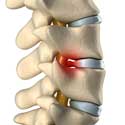Five Steps to Prevent Lower Back Pain
 No matter our age or physical condition, we can all get lower back pain at some point in our lives. A Centers for Disease Control study once found that more than 25% of adults suffered lower back pain in the previous three months. In addition, another survey by The Consumer Reports Health Ratings Center of 14,000 subscribers who experienced back pain but who had never had surgery for it found that about 80 percent of adults in the U.S. have complained of back pain at some point. That’s a lot of pain. Even so, you should not think of lower back pain as unavoidable or a fact of life as you get older.
No matter our age or physical condition, we can all get lower back pain at some point in our lives. A Centers for Disease Control study once found that more than 25% of adults suffered lower back pain in the previous three months. In addition, another survey by The Consumer Reports Health Ratings Center of 14,000 subscribers who experienced back pain but who had never had surgery for it found that about 80 percent of adults in the U.S. have complained of back pain at some point. That’s a lot of pain. Even so, you should not think of lower back pain as unavoidable or a fact of life as you get older.
The takeaway: Here are five initiatives you can do, on your own, to prevent lower back pain from happening too often or becoming too serious.
Tip #1: Get Up and Get Moving
The most important thing you can do to keep you and your spine healthy is to exercise. The best way to start is to think of an activity that you enjoy, and do it!!
Your goal should be to exercise at least 30 minutes each day, or most days of the week. Whatever activity you choose, make sure it gets you breathing a little harder than usual. This is good for your circulation. Examples are:
- Walking
- Jogging
- Biking
- Swimming
- Gardening, if done vigorously
- Strength training for healthy, strong muscles
Tip #2: See Your Doctor Regularly
Regular checkups with your doctor are really critical to your overall health, no matter what your age. Make a plan to see your physician at least once a year to make sure all your systems are working smoothly.
If you are experiencing lower back pain, and can’t seem to find any relief, it’s definitely time to see your doctor. Today there are many treatment options available so you don’t have to live with back pain.
Tip #3: Lose Weight (If Needed)
It’s estimated that over two-thirds of all Americans are overweight. It’s important to know that obesity contributes to the development of heart disease, diabetes, high blood pressure, cancer and lower back pain.
While the spine is designed to carry and distribute the body’s weight, excessive weight can strain the spine. Eventually, the spine will begin to wear out. Give your spine a break by shedding those unwanted and unnecessary pounds. Don’t know how to start? Talk to your doctor and together you can find a weight loss and exercise plan that best suits your needs.
Tip #4: Have Good Posture
You may think that slouching when sitting or standing is relaxing your muscles. But actually, it makes your muscles work harder.
Good posture, which involves standing and sitting in a balanced and neutral position, is the best way to avoid straining your spine. One good habit my spine care colleague, Susan Klevans, taught me was to do a shoulder shrug every time you get out of a chair or get out of bed. This motion will serve as a reminder to get your spine into healthy posture. When your chin and shoulders are proud and your pelvis (midsection) is pushed forward your spine muscles work less and subsequently are less likely to fatigue or spasm.
Tip #5: Rest Easy and Properly
Sleep is an essential nutrient for our bodies and where we sleep can make all the difference. If you are having trouble sleeping or find that you wake in the morning more tired than when you went to bed, you may need to take a good look at where and how you sleep.
A good mattress allows you to maintain the same natural spinal alignment that you have when standing. When your body is allowed to rest in its natural position, muscles are relaxed and sleep is more refreshing. Here’s a brief slideshow on healthy sleep positions.
Furthermore stress reduction with brief periods of mental and physical breaks during your work day are critical for reducing many ailments and especially low back pain. I will write more on the “one minute vacation” in a future blog. But suffice it to say you will be more productive and have less back pain if you get in the habit of taking regular, brief (5 minutes or less every hour) breaks with a physical change in position and a mental hiatus–that is thinking about something different and soothing to your mind.
This “mental hiatus” or “one minute vacation” is most important for people in high stress and highly physical jobs. Even when I am doing surgery, about every hour I will step away from the table, sit or stand in a comfortable position often doing a “Susan Klevans shrug”, close my eyes for a minute or so and think of something relaxing. Sometimes a new nurse asks me what I’m doing. I tell them I’m taking a short break so that I can refocus more clearly at the task at hand. Often they say: “Wow, I think more surgeons should do that.” I have always believed this ritual keeps me more alert and less fatigued for any procedure I do.
While you may not be able to avoid some occasional lower back pain, keeping your back healthy will go a long way to keeping you in good shape.
